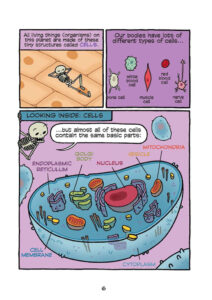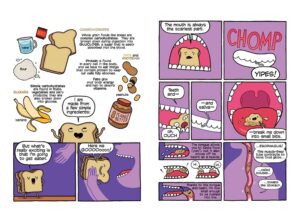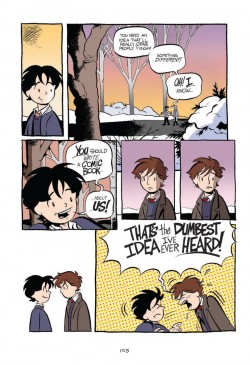 Human Body Theater
Human Body Theater
By Maris Wicks
First Second (a imprint of Roaring Brook and division of Macmillan)
$14.99
ISBN: 978-1-59643-929-0
Ages 9-12
On shelves now.
I gotta come clean with you. Skeletons? I’ve got a thing for them. Not a “thing” as in I find them attractive, but rather a “thing” as in I find them fascinating. I always have. Back in the 80s there was a science-related Canadian television show called “Owl TV” (a Canuck alternative to “3-2-1 Contact”) and one of the regular features was a skeleton by the name of Bonaparte who taught kids about various scientific matters. But aside from the odd viewing of “Jason and the Argonauts”, walking, talking (or, at the very least, stalking) skeletons don’t crop up all that often when you become grown. So maybe my attachment to Human Body Theater with its knobby narrator has its roots deep in my own personal history. Or maybe it has something more to do with the witty writing, untold gobs of nonfiction information, eye-catching art, and general sense of intelligence and care. Whatever the case, it turns out the human body puts on one heckuva good show!
When a human skeleton comes out and offers to right there, before your very eyes, become a fully formed human being with guts, skin, etc. who are you to refuse? Tonight the human body itself is putting on a show and everyone from the stagehands (the cells) to the players (whether they’re body parts or viruses) is fully engaged and involved. With our narrator’s help we dive deep beneath the skin and learn top to bottom about every possible system our bods have to offer. When all is said and done the readers aren’t just intrigued. They’re picking the book up to read it again and again. Backmatter includes a Glossary of terms and a Bibliography for further reading.
 I’ve been a big time Maris Wicks fan for years. It started long ago when I was tooling around a MOCCA (Museum of Comic and Cartoon Art) event and ran across just the cutest little paperback picture book. It couldn’t have been much bigger than a coaster and all it was was a story about a family taking a daytrip to the woods. Called Yes, Let’s it was written by Galen Goodwin and illustrated by a Maris Wicks. I didn’t know either of these people. I just knew the book was good, and when it was published officially a couple years later by Tanglewood Publishing I felt quite justified. But for all that I’d been a fan, I didn’t recognize Ms. Wicks’ work or name, at first, when she illustrated Jim Ottaviani’s Primates. When the connection was made I felt like I’d won a small lottery. Now she’s gone solo with Human Body Theater and the only question left in anybody’s mind is . . . why didn’t she do it sooner? She’s a natural!
I’ve been a big time Maris Wicks fan for years. It started long ago when I was tooling around a MOCCA (Museum of Comic and Cartoon Art) event and ran across just the cutest little paperback picture book. It couldn’t have been much bigger than a coaster and all it was was a story about a family taking a daytrip to the woods. Called Yes, Let’s it was written by Galen Goodwin and illustrated by a Maris Wicks. I didn’t know either of these people. I just knew the book was good, and when it was published officially a couple years later by Tanglewood Publishing I felt quite justified. But for all that I’d been a fan, I didn’t recognize Ms. Wicks’ work or name, at first, when she illustrated Jim Ottaviani’s Primates. When the connection was made I felt like I’d won a small lottery. Now she’s gone solo with Human Body Theater and the only question left in anybody’s mind is . . . why didn’t she do it sooner? She’s a natural!
Now for whatever reason my four-year-old is currently entranced by this book. She’s naturally inclined to love graphic novels anyway (thank you, Cece Bell) and something in Human Body Theater struck a real chord with her. It’s not hard to figure out why. Visually it’s consistently arresting. Potentially dry material, like the method by which oxygen travels from the lungs to the blood, is presented in the most eclectic way possible (in this case, like a dance). Wicks keeps her panels vibrant and consistently interesting. One minute we might be peering into the inner workings of the capillaries and the next we’re zooming with the blood through the body delivering nutrients and oxygen. The colorful, clear lined style certainly bears a passing similarity to the work of author/artists like Raina Telgemeier, while the ability imbue everything, right down to the smallest atom, with personality is more along the lines of Dan Green’s “Basher Books” series.
For my part, I was impressed with the degree to which Wicks is capable of breaking complex ideas down into simple presentations. The chapters divide neatly into The Skeletal System, The Muscular System, The Respiratory System, The Cardiovascular System, The Digestive System, The Excretory System, The Endocrine System, The Reproductive System, The Immune System, The Nervous System, and the senses (not to mention an early section on cells, elements, and molecules). As impressive as her art is, it’s Wicks’ writing that I feel like we should really credit here. Consider the amount of judicious editing she had to do, to figure out what to keep and what to cut. How do you, as an author, transition neatly from talking about reproduction to the immune system? How do you even tackle a subject as vast as the senses? And most importantly, how gross do you get? Because the funny bones of 10-year-olds demand a certain level of gross out humor, while the stomachs of the gatekeepers buying the book demand that it not go too far. I am happy to report that Ms. Wicks walks that tightrope with infinite skill.
 One of the parts of the book I was particularly curious about was the sex and reproduction section. I’ve seen what Robie H. Harris has gone through with her It’s Perfectly Normal series on changing adolescent bodies, and I wondered to what extent Wicks would tread similar ground. The answer? She doesn’t really. Sex is addressed but images of breasts and penises are kept simple to the point of near abstraction. As such, don’t be relying on this for your kid’s sex-ed. There are clear reasons for this limitation, of course. Books that show these body parts, particularly graphic novels, are restricted by some parents or school districts. Wicks even plays with this fact, displaying a sheet covering what looks like a possible penis, only to reveal a very tall sperm instead. And Wicks doesn’t skimp on the info. The chapter on The Reproductive Cycle, for example, contains the delightful phrase, “ATTENTION: Would some blood please report to the penis for a routine erection.” So I’ve no doubt that there will be a parent somewhere who is offended in some way. However, it’s done so succinctly that I wouldn’t be the least bit surprised if it causes almost no offense during its publication lifespan (but don’t quote me on that one).
One of the parts of the book I was particularly curious about was the sex and reproduction section. I’ve seen what Robie H. Harris has gone through with her It’s Perfectly Normal series on changing adolescent bodies, and I wondered to what extent Wicks would tread similar ground. The answer? She doesn’t really. Sex is addressed but images of breasts and penises are kept simple to the point of near abstraction. As such, don’t be relying on this for your kid’s sex-ed. There are clear reasons for this limitation, of course. Books that show these body parts, particularly graphic novels, are restricted by some parents or school districts. Wicks even plays with this fact, displaying a sheet covering what looks like a possible penis, only to reveal a very tall sperm instead. And Wicks doesn’t skimp on the info. The chapter on The Reproductive Cycle, for example, contains the delightful phrase, “ATTENTION: Would some blood please report to the penis for a routine erection.” So I’ve no doubt that there will be a parent somewhere who is offended in some way. However, it’s done so succinctly that I wouldn’t be the least bit surprised if it causes almost no offense during its publication lifespan (but don’t quote me on that one).
If there is a problem with the book it may come right at the very beginning. Our skeleton hero introduces herself and from there you would expect her to jump right in to Human Body Theater with the bones. Instead, the storyline comes to a near screeching halt from the get go with a laborious explanation of cells, elements, and molecules. It’s not that these things aren’t important or interesting. Indeed, you can more than understand why they come at the beginning the way that they do. But as the book currently stands, this section feels like it was added in at the last minute. If it was going to preface the actual “show” then couldn’t it have been truly separate from the main event and act as a kind of pre-show entertainment?
What parent wouldn’t admit a bit of a thrill when their kid points to their own femur and declares proudly that it’s the longest bone in the human body? Or off-the-cuff speculates on the effects of the appendix on other body functions? We talk a lot about children’s books that (forgive the phrase) “make learning fun”, but how many actually do? When I wrack my brain for fun human body books, I come up surprisingly short. Here then is a title that can push against a certain kind of reader’s reluctance to engage with science on any level. It’s for the science lovers and graphic novel lovers alike (and lord knows the two don’t always overlap). More fun than it has any right to be. No bones about it.
On shelves now.
Like This? Then Try:
- Human Body: A Book with Guts by Dan Green
- The Way We Work: Getting to Know the Human Body by David Macaulay
- Human Body Factory by Dan Green
Source: Final copy sent from publisher for review.
Interviews: A great one conducted with Mara and The A.V. Club.






I reviewed–and loved–this book when it first came out. I’ve been surprised it hasn’t gotten more notice!
Well they were weird about the galleys. Didn’t send them out to the usual reviewers and library systems. Most peculiar indeed.
Perfect! My book club meets this afternoon, my copy of The Dumbest Idea Ever is on the shelf, and the kids love watching book trailers. Thanks, Betsy!
BTW, I, too, loved Amelia Rules.
“I own every single book in the series and reread them constantly.” You too?! I’ve read his Amelia series since it was a comic book and absolutely loved it! He’s one of those author/illustrators I follow, like Raina Telgemeier, Linda Medley, Sergio Aragones, Wendy Pini and others who sparkle and shine in the children’t books landscape. I’m so glad there are so many today, because when I was growing up there was so much less to choose from. I’m delighted I can offer so many quality authors and illustrators to the kids in my school. I’d recommend Gownley to anyone, adult or child.
[...] Gownley, Jimmy. The Dumbest Idea Ever. A Fuse #8 Production [...]
Amerlia Rules! is my go-to suggestion when people are looking for recommendations for GN for tweens/teens.